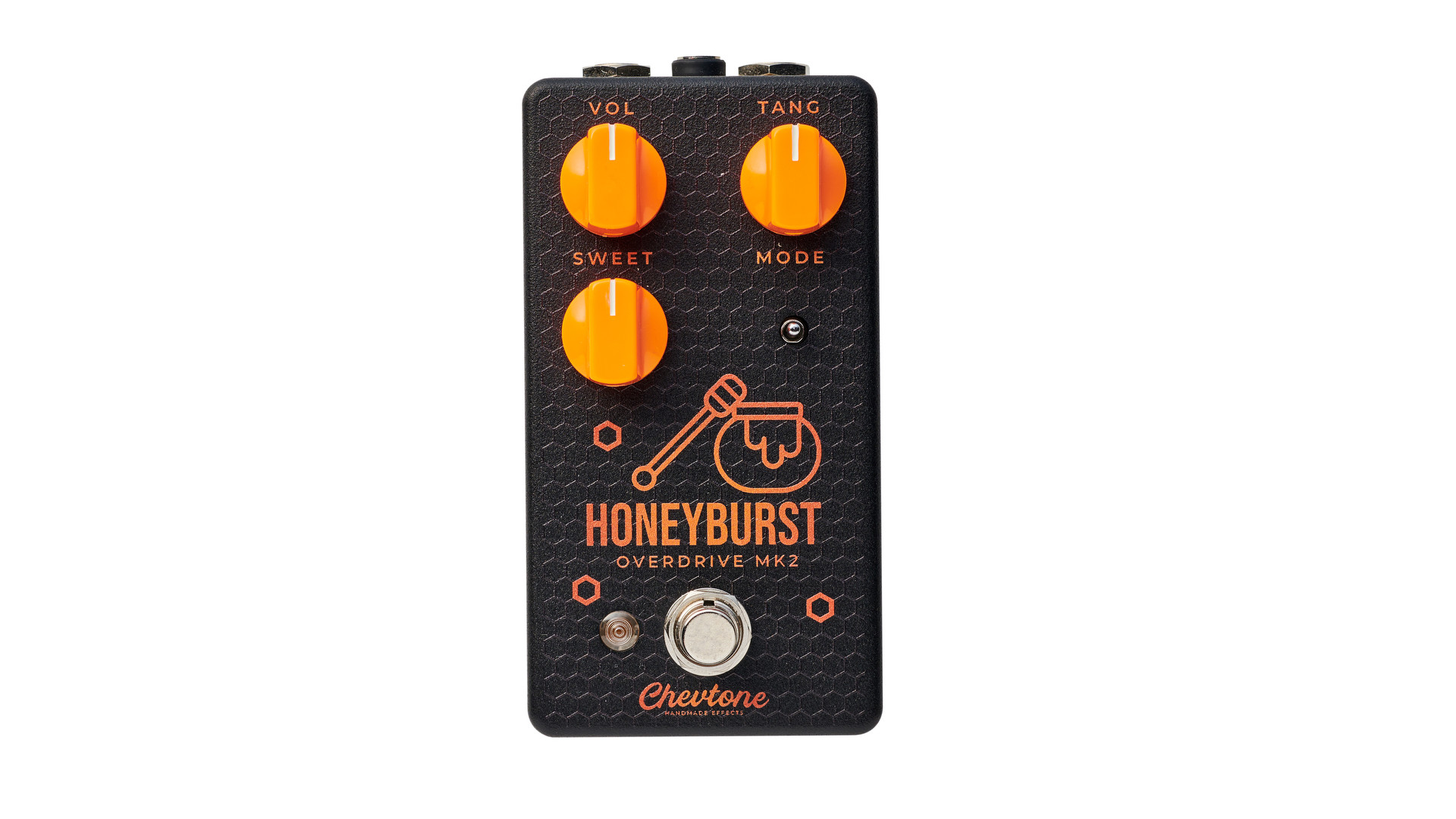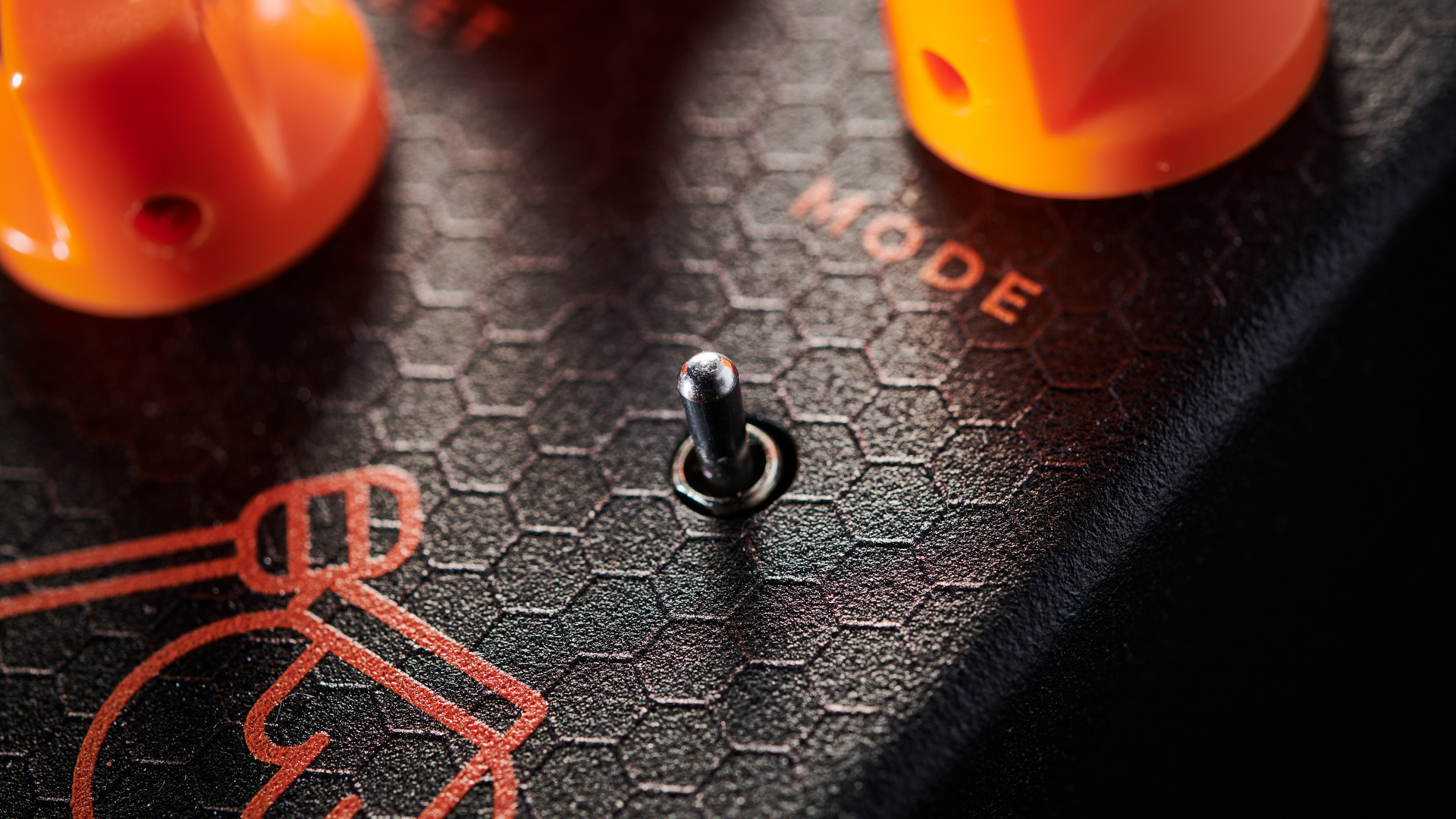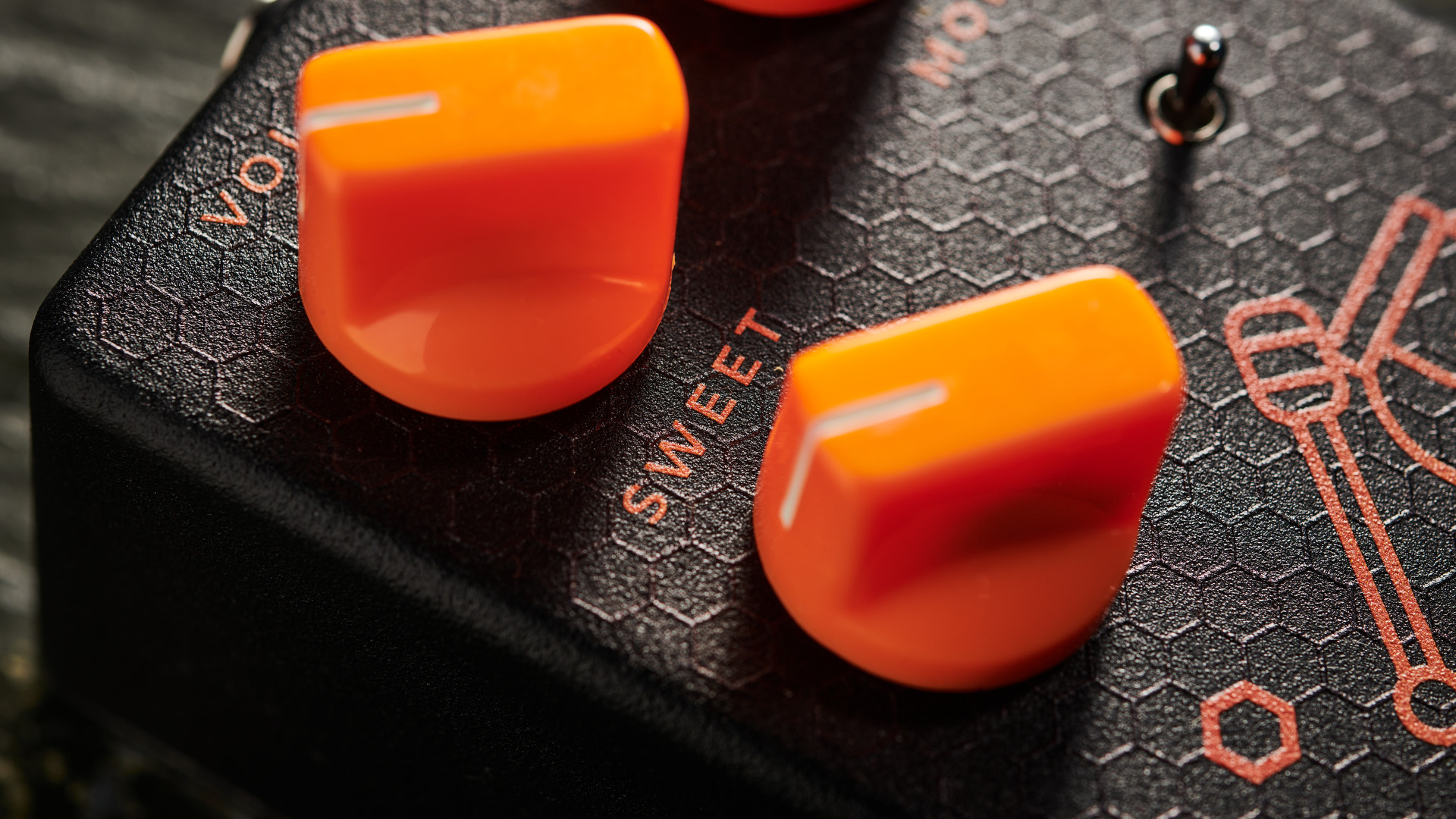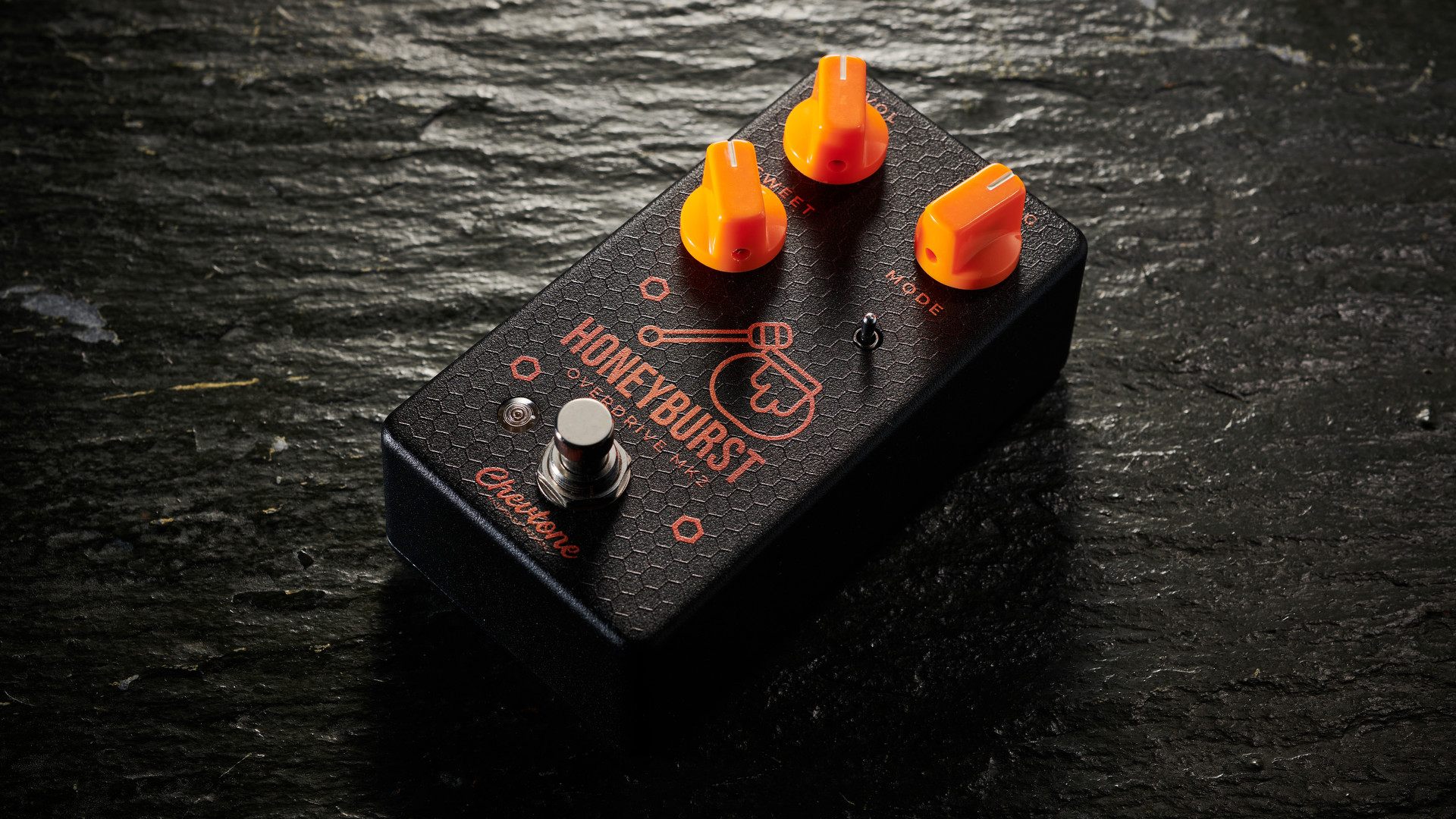MusicRadar Verdict
If you’re looking for a boost that’s ahem…’bursting with character then we’d suggest getting on-board before the secret is out.
Pros
- +
Versatile overdrive/boost pedal
- +
Handmade in the UK
- +
Affordable
Cons
- -
Not an 'against' per se; currently only available via Reverb
MusicRadar's got your back
Chevtone Effects Honeyburst Overdrive pedal: What is it?

How much does £100-ish buy you when it comes to an overdrive pedal? You don’t have to look too far back in time for the answer to that question to be “Quite a bit, actually”. But this is 2023, and with a global cost-of-living crisis hitting every aspect of our lives, our hard-earned dough is being stretched further than the sliced bread we’re spending it on.
Simultaneously, the pedal market can be a bit like coffee and ale at times - phrases such as ‘small batch’, ‘boutique’, and anything involving the effort of a human being rather than a machine are usually red flags for thrifty guitarists. But here, Adam Yeomans has put together a multi-mode, handmade overdrive pedal using decent components and built by skin and bones for a surprisingly low price.
The Honeyburst isn’t Chevtone’s first outing, joining the Messiah Drive and Preacher Drive in the line-up.

On the face of it, the Honeyburst is a pretty straightforward overdrive pedal. It comes in a painted box (complete with a subtle honeycomb pattern), with top-mounted sockets, three controls, a mini-toggle and a bypass switch. The controls are labelled Vol (you know what that is) Tang (that’s drive to you) and Sweet (that’ll be the tone control), capped with bright orange knobs, they’re bold and unmissable. But it’s the Mode toggle that makes this more than just-another-overdrive-pedal.
Here, we get to choose the flavour of the Honeyburst’s gain, as Chevtone’s circuit implements germanium, silicon and LED clipping diodes. Why would we want to do that? Well, as overdrive fans will know, each of these clipping methods has its own signature: germanium was used in many a vintage fuzz pedal and is revered for its smooth-sounding, colourful high gain. Silicon typically provides a slightly lower amount of gain and LEDs, meanwhile, offer a high amount of headroom, making this a great option when lower-gain transparency is required - in a boost for example.
So, what we’ve got in the Honeyburst are three options for different requirements. Time to see what the buzz is all about.
Chevtone Effects Honeyburst Overdrive pedal: Performance and sounds

The Honeyburst is designed to be a low-gain overdrive/boost rather than an all-out amp-in-a-box type source of overdrive. So, we started with our valve amp set on a fairly clean tone - just on the edge of breaking up - and with the pedal’s output set to match the volume of our clean channel to get a reference point. From here, we started upping the Tang to about halfway while also pushing the Volume control slightly. With these settings we’re really in boost territory, and with the toggle switch in the middle ‘LED’ position there’s an apparent level and low-end kick.
Of course, the other clipping modes will also serve this purpose too - we’re talking subtleties rather than entirely different circuits - but as a boost the LED mode works like a charm for those situations where you just want ‘more’ without dramatically changing your feel or tone.

The gravelly, hard-edged, throaty tones coming from the silicon and germanium modes really come into play with the gain turned up
From here you have a choice - upping the output works our amp’s preamp harder while still remaining transparent, but roll in a little more of the Tang control and the Honeyburst’s diodes start to impart more colour on the sound. This comes in the form of added bite and presence from all three modes for a solid rock overdrive sound when played with humbuckers. But the gravelly, hard-edged, throaty tones coming from the silicon and germanium modes really come into play with the gain turned up. We did find that the LED mode started to become muddy at higher-gain settings, particularly when pushing into higher-gain amp settings. But with both the silicon and germanium modes, our note separation remains intact and we have a rock rhythm sound with added punch for very little effort.
But while it’s sensible to remain in that territory, the real fun with any gain supplier is to crank it and see exactly how far it’ll go. The result is some pretty abrupt clipping that while we can’t really call full-on fuzz – it’s still overdrive, but it definitely has a vintage, fuzzy edge to it. If you’re looking for '60s-style tones, you’ll find them here: bags of compression and sustain while still maintaining clarity. With our neck single coil engaged, it’s part Hendrix/part garage rock. Back on the bridge humbucker, there’s a definite Smashing Pumpkins vibe to the germanium mode at higher gain settings, and tuned-down, we get some cool stoner-rock type tones that lean towards the lower-gain, grinding side of QOTSA.

For what seems like a simple pedal, there are plenty of ways to use the Honeyburst thanks to the Mode toggle
Curiously, the germanium mode displayed a little more aggression to our ears in the ‘ripped velcro’ type fuzz territory than the silicon, which is the reverse of what we were expecting.
For what seems like a simple pedal, there are plenty of ways to use the Honeyburst thanks to the Mode toggle. As a boost, we liked the silicon and LED modes the best: allowing our amp to take the tonal strain and squeeze a little more out of the preamp valves. With the Honeyburst controls dimed, the germanium mode is where it holds most of its character.

We have to hand it to Chevtone. The Honeyburst looks brilliant, works for a surprising number of applications and sounds great for all of them. It can sometimes seem like everyone and their soldering iron is vying for a plot on your pedalboard, but there’s a lot to like here.
MusicRadar verdict: If you’re looking for a boost that’s ahem…’bursting with character then we’d suggest getting on-board before the secret is out.
Chevtone Effects Honeyburst Overdrive pedal: Hands-on demos
Leigh Fuge
Budget Pedal Chap
AM Guitar
Chevtone Effects Honeyburst Overdrive pedal: Specifications

Type: Overdrive/Boost
Controls: Vol, Tang (gain) Sweet (tone), clipping mode toggle switch (silicon, LED germanium)
Connectivity: Input, output, power
Power: 9v PSU only
Contact: Chevtone (via Reverb)
Meet the maker: Chevtone Effects' Adam Yeomans

How did you get into pedal building and what inspired you to start Chevtone Effects?
Adam: "Like many builders, I started with repairing old pedals and pedal building kits like Fuzzdog and Jedspeds. And after a while I started playing with old tagboard and veroboard circuits using vintage components. At the same time I started building vintage Marshall amp clones which furthered my understanding of audio circuit design and made me really fall in love with modding circuits and using vintage design principles.
"I started Chevtone because, at the time, there seemed to be a small gap in the market for hand-built, vintage inspired pedals, but with a more modern look. And after sending some of the early prototypes to friends and fellow builders, I was assured that they needed to be available to the public. So after much thought and investment I decided to make the jump and start up around May 2020.
"Chevtone has changed over the years, starting with vintage tagboard design that was greatly inspired by the great Joe at Hello sailor effects.
"Then onto my personal favourites that were a mix of top end modern components and vintage caps and diodes on bespoke modern PCBs, which can still be ordered and built on request. And the current versions are a mix of SMD and through-hole components at a more budget-friendly price."
What were the influences and aims behind the Honeyburst overdrive?
Adam: "I wanted to create a super versatile overdrive pedal that could go from transparent light drive, to an almost fuzzy saturated drive with that squishy vintage feel.
"I was influenced by the famous bufferless TS-style circuits, but saw an opportunity to expand the circuit's structure and create an array of different tones at the flick of a switch.
"The Honeyburst has become a big favourite of everyone who has played one, which fills me with a lot of pride."
The high-gain side leans more towards Gary Moore's '90s blues sound. Even though Gary used Soldanos, he was also famous for his love for the black and gold stacks
Can you talk us through the other two pedals in your current range?
Adam: "The Preacher is a low gain overdrive that goes between low watt JTM and Tweed voice gain tones. Not really created to be a stand-alone overdrive, but more of a voicing tool. The newest version of the Preacher comes with an internal switch that engages a preamp at the front of the gain circuit that really kicks things up a notch and acts like you are pushing the front end of a tube amp with a boost pedal.
"Last but not least is the Messiah, I see this as my flagship pedal. It's a Marshall-inspired overdrive with a two band EQ that is voiced to create the tones of two of my favourite Marshall players.
"A toggle switch selects between a high and a low gain baseline setting. The low gain side is voices on one of my original Marshal Clone builds that was based around a 50W Black Flag plexi which I modded to be more in line with Paul Kossoff's raucous, grainy low gain tones.
"The high-gain side leans more towards Gary Moore's '90s blues sound. Even though Gary used Soldanos, he was also famous for his love for the black and gold stacks. With a smooth luxurious saturation and tones of gain, but still preserving a natural articulation that Gary's tones are famous for.
"But with the aid of the two-band EQ, there are a ton of tones to extract from the little purple tone box – Koss to Moore and so much more!"
I just think we all need to stick together in this industry as it seems to be getting more and more difficult to survive as an independent builde
Do you think there is a good support network for pedal builders in the UK and worldwide?
Adam: "I think it's getting better, but there also seems to be a lot of gatekeeping in certain circles. There are some absolutely fantastic builders out there that are happy to help, teach and guide others. And if it wasn't for guys like Joe at Hello sailor, Stuart from Tate FX, Simon at JSA Effects, Alex at Zander Effects (who created the artwork for my pedals) and Adam Richards (AKA budget pedal chap) Chevtone would never have happened. I just think we all need to stick together in this industry as it seems to be getting more and more difficult to survive as an independent builder.
What have been the biggest challenges for you as a small operation?
"Lately its been the price of parts. There has been a considerable increase in costs, but if I was to push up the price of the pedals to compensate it would push them above the price range I intended for the current lineup.
"Also, with certain big pedal companies now creating sub £100 pedals and an abundance of super cheap Chinese clones being so readily available, it's getting more difficult for the average player to warrant paying extra for a smaller, relatively unknown builder for their product instead. That is why I decided to create the current lineup where they are more affordable and are quicker to build."
What are your aims for Chevtone in the future?
"I've just set up my own company in my day-to-day career, that specialises in high-end supercars and motorsports, so a lot of my time is currently taken up with getting the new company off the ground, but I've got two pedals in the works that will hopefully be available later in the year.
"Both are dual pedals, and one of them is based on the early tones of a certain bearded reverend. I'm excited to expand the range, and I know there are people out there that are waiting for some new stuff."

I'm a freelance member of the MusicRadar team, specialising in drum news, interviews and reviews. I formerly edited Rhythm and Total Guitar here in the UK and have been playing drums for more than 25 years (my arms are very tired). When I'm not working on the site, I can be found on my electronic kit at home, or gigging and depping in function bands and the odd original project.
“I used everything I knew about music”: How Green Day exceeded expectations with their most ambitious song
YouTube just added AI tools that makes musicians, library music and video editors redundant
“Every one of them said yes without hesitation": Hank Marvin and Roger Taylor have just remade a '60s classic for charity










